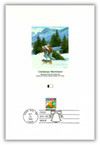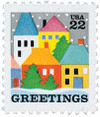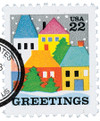
# 2245 - 1986 22c Contemporary Christmas: Winter Village Scene
U.S. #2245
1986 22¢ Winter Village Scene
Contemporary Christmas
- 22nd Contemporary Christmas issue
Stamp Category: Commemorative, Definitive, Express Mail, semi-postal, airmail
Series: Contemporary Christmas
Value: 22¢, first-class rate
First Day of Issue: October 24, 1986
First Day City: Snow Hill, Maryland
Quantity Issued: 882,150,000
Printed by: Bureau of Engraving and Printing
Printing Method: Photogravure
Format: Panes of 100 in sheet of 800
Perforations: 11
Why the stamp was issued: For use on holiday mail.
About the stamp design: Dolli Tingle submitted her design for this stamp several years before it was used. When the USPS chose to use it in 1986, some changes were made, mainly moving around buildings and trees.
First Day City: The First Day ceremony for this stamp was held at Snow Hill Senior High School, in Snow Hill, Maryland. The site was selected as it’s the ancestral home of stamp artist Dolli Tingle.
About the Contemporary Christmas Series: By the early 1960s, the US Post Office was receiving 1,000 letters a year (for several years) asking for a Christmas-themed stamp to frank their holiday mail. The idea was approved and the US issued its first Christmas stamp on November 1, 1962.
The stamp was wildly popular, featuring popular holiday decorations of a wreath and candles. The Post Office Department had expected there would be a great demand for the issue, so they printed 350 million stamps – the largest print run for a special stamp up to that time. Those 350 million stamps sold out quickly, leading the Bureau of Engraving and Printing to produce more stamps – reaching over 860 million by the end of the year.
While the Christmas stamp was very popular, it wasn’t without its detractors. Some didn’t agree with the idea of the post office issuing a stamp honoring a religious holiday. Others wanted Christmas stamps that were more religious. The Post Office would continue to issue Christmas stamps in the coming years that featured the National Christmas Tree, seasonal plants, and an angel in 1965. The angel was considered less controversial because angels are included in many religions, not just Christianity.
In 1966, the Post Office came up with a plan to produce Christmas stamps utilizing classic paintings of the Madonna and Child. These stamps wouldn’t violate the separation of church and state because they were a celebration of culture. On November 1, 1966, they issued the first US Madonna and Child stamp in Christmas, Michigan. The stamp featured the 15th century painting, Madonna and Child with Angels, by Flemish painter Hans Memling.
That stamp was very popular and over 1.1 billion were printed. The same design was used again the following year, however, the 1967 stamp was larger and showed more of the painting. The stamp’s continued popularity led the Post Office to issue another traditional Christmas stamp in 1968, this time picturing the Angel Gabriel. For the 1969 issue, they reverted back to the non-religious theme, with a stamp picturing a painting called Winter Sunday in Norway, Maine.
The Post Office made a big change in 1970. To keep people in both camps happy, they issued one traditional Christmas stamp, picturing a classic painting of the Nativity, plus a block of four picturing Christmas toys. That decision proved popular and they have continued to issue stamps with both traditional and contemporary Christmas themes ever since.
History the stamp represents: The contemporary Chrismas issue features a colorful and wintry village scene, and was issued in Snow Hill, Maryland. A small village that serves as the county seat of Worcester County, Snow Hill was also the setting for some scenes in the Julia Roberts and Richard Gere movie, Runaway Bride. The scenes at the baseball and football games were filmed behind Snow Hill High School.
U.S. #2245
1986 22¢ Winter Village Scene
Contemporary Christmas
- 22nd Contemporary Christmas issue
Stamp Category: Commemorative, Definitive, Express Mail, semi-postal, airmail
Series: Contemporary Christmas
Value: 22¢, first-class rate
First Day of Issue: October 24, 1986
First Day City: Snow Hill, Maryland
Quantity Issued: 882,150,000
Printed by: Bureau of Engraving and Printing
Printing Method: Photogravure
Format: Panes of 100 in sheet of 800
Perforations: 11
Why the stamp was issued: For use on holiday mail.
About the stamp design: Dolli Tingle submitted her design for this stamp several years before it was used. When the USPS chose to use it in 1986, some changes were made, mainly moving around buildings and trees.
First Day City: The First Day ceremony for this stamp was held at Snow Hill Senior High School, in Snow Hill, Maryland. The site was selected as it’s the ancestral home of stamp artist Dolli Tingle.
About the Contemporary Christmas Series: By the early 1960s, the US Post Office was receiving 1,000 letters a year (for several years) asking for a Christmas-themed stamp to frank their holiday mail. The idea was approved and the US issued its first Christmas stamp on November 1, 1962.
The stamp was wildly popular, featuring popular holiday decorations of a wreath and candles. The Post Office Department had expected there would be a great demand for the issue, so they printed 350 million stamps – the largest print run for a special stamp up to that time. Those 350 million stamps sold out quickly, leading the Bureau of Engraving and Printing to produce more stamps – reaching over 860 million by the end of the year.
While the Christmas stamp was very popular, it wasn’t without its detractors. Some didn’t agree with the idea of the post office issuing a stamp honoring a religious holiday. Others wanted Christmas stamps that were more religious. The Post Office would continue to issue Christmas stamps in the coming years that featured the National Christmas Tree, seasonal plants, and an angel in 1965. The angel was considered less controversial because angels are included in many religions, not just Christianity.
In 1966, the Post Office came up with a plan to produce Christmas stamps utilizing classic paintings of the Madonna and Child. These stamps wouldn’t violate the separation of church and state because they were a celebration of culture. On November 1, 1966, they issued the first US Madonna and Child stamp in Christmas, Michigan. The stamp featured the 15th century painting, Madonna and Child with Angels, by Flemish painter Hans Memling.
That stamp was very popular and over 1.1 billion were printed. The same design was used again the following year, however, the 1967 stamp was larger and showed more of the painting. The stamp’s continued popularity led the Post Office to issue another traditional Christmas stamp in 1968, this time picturing the Angel Gabriel. For the 1969 issue, they reverted back to the non-religious theme, with a stamp picturing a painting called Winter Sunday in Norway, Maine.
The Post Office made a big change in 1970. To keep people in both camps happy, they issued one traditional Christmas stamp, picturing a classic painting of the Nativity, plus a block of four picturing Christmas toys. That decision proved popular and they have continued to issue stamps with both traditional and contemporary Christmas themes ever since.
History the stamp represents: The contemporary Chrismas issue features a colorful and wintry village scene, and was issued in Snow Hill, Maryland. A small village that serves as the county seat of Worcester County, Snow Hill was also the setting for some scenes in the Julia Roberts and Richard Gere movie, Runaway Bride. The scenes at the baseball and football games were filmed behind Snow Hill High School.












